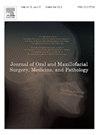Satisfaction questionnaire survey after surgical orthodontic treatment in patients with jaw deformities
IF 0.4
Q4 DENTISTRY, ORAL SURGERY & MEDICINE
Journal of Oral and Maxillofacial Surgery Medicine and Pathology
Pub Date : 2024-10-06
DOI:10.1016/j.ajoms.2024.10.001
引用次数: 0
Abstract
Objective
Surgical orthodontic treatment leads to morphological, functional and psychological changes in patients with jaw deformities. For the evaluation of outcomes of surgical orthodontic treatment from the patient's point of view, a questionnaire survey was performed after treatment and factors affecting patient satisfaction were examined.
Methods
A survey by mailing questionnaires that each consisted of 30 items was conducted in 250 patients with jaw deformities who underwent orthognathic surgery in our department during the period from January 2015 to December 2020. Eighty-four patients responded (response rate of 34.0 %). The patients who responded included 24 males and 60 females. The mean age at the time of surgery was 26 years.
Results
Fifty-four patients complained of morphological abnormalities such as facial appearance and malocclusion, and 30 patients complained of functional disturbances such as masticatory disabilities. Eighty-two patients were satisfied with the outcome of surgery, but there were two patients with postoperative paresthesia and residual facial asymmetry who were not satisfied with the outcome. Improvements were observed in mastication and pronunciation in 74 and 46 patients, respectively. Psychologically, 26 patients showed positive personality changes postoperatively. Thirty-three patients had TMJ symptoms before surgery, and the symptoms were resolved after surgery in 24 of those patients. Two patients developed snoring during sleep after surgery.
Conclusions
This survey showed that most patients with jaw deformities were satisfied with the results of surgical orthodontic treatment.
求助全文
约1分钟内获得全文
求助全文
来源期刊

Journal of Oral and Maxillofacial Surgery Medicine and Pathology
DENTISTRY, ORAL SURGERY & MEDICINE-
CiteScore
0.80
自引率
0.00%
发文量
129
审稿时长
83 days
 求助内容:
求助内容: 应助结果提醒方式:
应助结果提醒方式:


